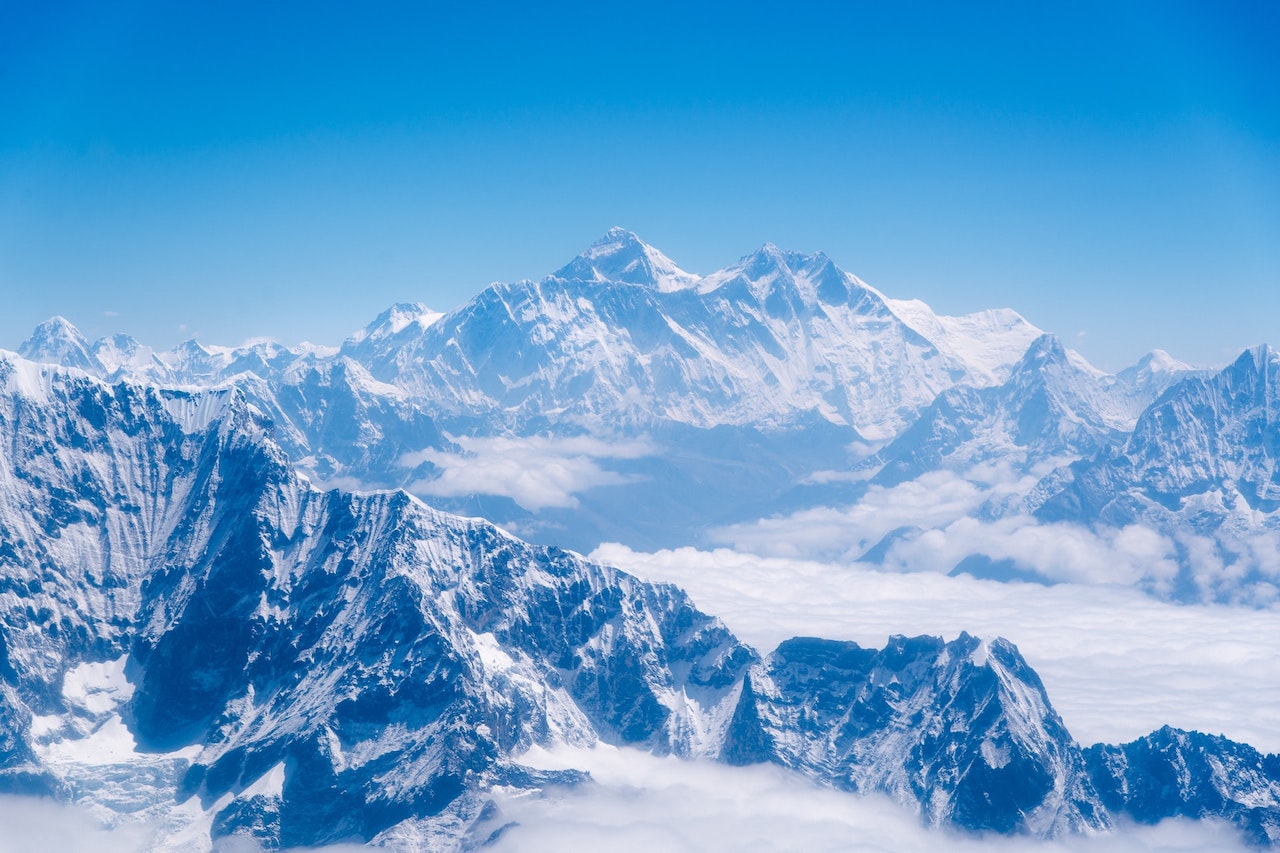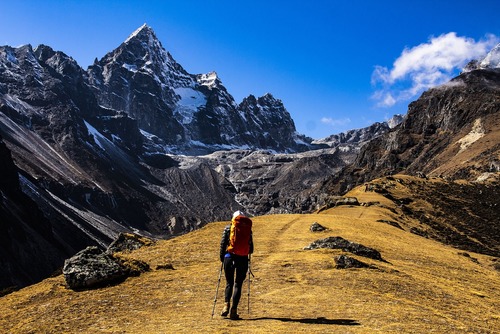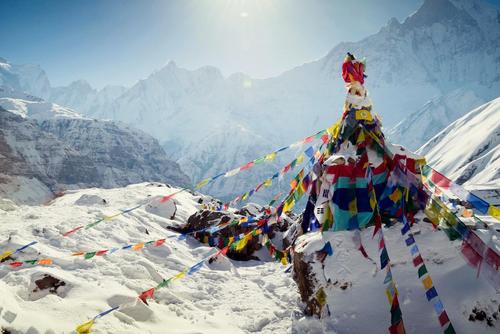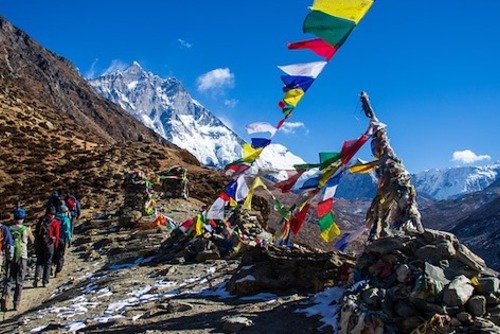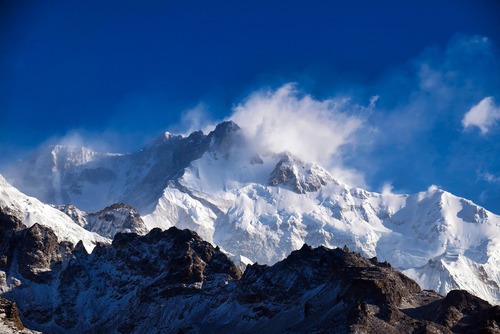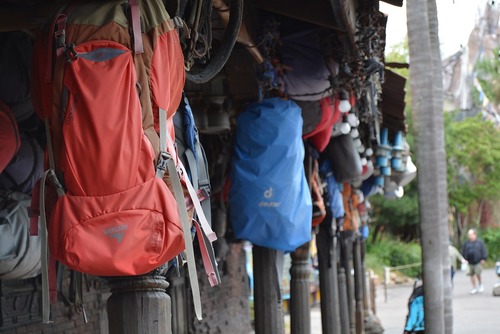This is a 16-day ultimate trekking adventure to the foot of the Mighty Everest. Mount Everest is the highest mountain of the world, towering at more than 8,500 meters. The Everest region became famous when Sir Edmund Hillary and Tenzing Norgay Sherpa ascended the peak in 1954 AD. Since then, thousands of climbers have summited or tried summiting the mountain.
On this EBC trek, you’ll pass through the country’s first-ever natural heritage site, the Sagarmatha National Park. Inside, you’ll find Himalayan vegetation flourishing in its natural habitat and some wildlife running around in front of you. You may get a chance to witness some endangered species, like snow leopards, if you’re lucky.
While on the Everest Base Camp Trek, you’ll interact with the local Sherpas, one of the ethnic Tibetan groups. You get to learn about their Himalayan lifestyle and their traditions as well. They offer modern infrastructure and amenities to every traveler who steps into this region.
If you plan your trek accordingly, you may also get a chance to get involved in their festivities, like Mani Rimdu as well. While you’re there, you can also try their local cuisines too. Their diet mainly consists of energy-giving foods like Dal Bhat, Dhendo, Thukpa, Porridge, etc.
Highlights
As you might have known, the EBC is the top choice for every trekker worldwide. The main reason it got its fame is the famous climb of Sir Edmund Hillary and Tenzing Norgay Sherpa in 1954 AD. It was the first time in history that anyone had climbed to the top of Mount Everest.
To reach the base of Everest, you’ll have to first land at one of the highest-altitude airports in the world, Lukla Airport. This is one of the most thrilling and challenging airports in all of Nepal.
On your way to the base camp, you have to pass through the Sagarmatha National Park, which is Nepal’s first natural heritage site. Here, you can explore the beauty of the diverse range of Himalayan flora and faunas in their own natural habitat.
One of the best highlights of this entire journey is a trip though the Namche Bazaar. You’ll see an example of modernization mixed with tradition and culture. Your stay here will be comfortable as there are comfortable lodges, restaurants, bakeries, and all the amenities you can hope for.
Another attraction in this region is the Everest View Hotel, one of the highest placed hotel in the world. Catch a panoramic glimpse of all the mountain range, as far as your eyes can see. Marvel at the snow-capped peaks for the hotel’s viewpoint.
You can also visit the spiritual Tengboche Monastery, one of the largest monasteries in the region. Feel the positive and religious vibes once you step into the monastery. Witness monks praying and get lost in their chants and hymns.
On your way to EBC, you’ll see the mighty Khumbu Glaciers as well. This glacier is about 180 square kilometer in area and was formed approximately 500,000 years ago.
You can also view a mesmerizing sunrise from Kala Patthar, another major attraction in this Everest Base Camp Trek. Witness a stunning sunrise striking against Mount Everest and its neighboring peaks.
The ultimate goal on this base camp trek is to reach the Everest Base Camp. Get a 360-degree panoramic view of the entire Himalayan ranges and view peaks like Ama Dablam, Lhotse, Nuptse, etc.
Preparation Guide
- Physical Fitness and training:
Engage in physical activities like running, cycling, swimming, or going to the gym. Focus more on your legs, core, and back muscles with exercises like squatting, lunges and weight lifts. You can also go for hikes at your local hiking locations to help you get used to long walk. - Travel documents and permits: You have to ensure your passport is valid for at least 6 months even after you get your Nepalese visa. Before you arrive in Nepal, secure your TIMS (Trekker Information Management System) and Sagarmatha National Park permit.
- Health and Safety: Ensure you’re vaccinated and check which vaccinations are recommended for Nepal. Also pack your necessary personal medications which you have to take regularly. Also recommended is to get a comprehensive travel insurance, which covers emergency evacuation, high-altitude rescue and hospital expenses.
- Route and Itinerary planning: Make yourself familiar with the standard EBC route via Lukla, Phakding, Namche, Tengboche, Dingboche, Gorak Shep and Kala Patthar. If you want some alternatives, research about Gokyo Lake trek for some different experience.
- Nutrition and hydration: On your trip, you should carry some high-energy snacks such as nuts, energy bars, dried fruits, etc. For hydrating, you can buy bottled water or fill up from springs and use a purification tablet or filter. For your en-route meal, you’ll have to rely on local establishments. Ensure you inform them and your guides about your allergies or gluten-free foods.
- Electricity and electrical ports during the trek: Almost every lodge and guesthouse has electricity. However, you have to keep in mind that the charging facilities are very limited and might not work sometimes. The establishments usually charge a fee for the charging station, and the price may differ from place to place. So, it is recommended that you carry a power pack with you to charge your devices.
In Nepal, the plugs are two and three-round pin plugs. The average voltage output is around 220 to 240 volts, and the frequency is 50 Hz. You can buy a universal adapter to fit all criteria.
- Money during the trek: You can withdraw or exchange your currency once you land at the airport or nearby your hotel. We recommend you carry cash on your trek for your personal expenses. Approximately NPR 3000 per day would be enough for all your personal expenses during the trek. An ATM in Nepal typically has a withdrawal limit of NPR 30,000 to NPR 50,000.
- Travel responsibly: We, at Nepal Hiking Team, promote a responsible and stable trekking practice. Our aim is to organize sustainable trips, promoting local businesses and providers. We give our effort at boosting local economies by directing resources to local ventures.
Pros and Cons of Everest Base Camp Trek
Pros:
- Stunning scenery: This EBC trek offers you stunning views of the Himalayas, including the mighty Everest, Lhotse, and Ama Dablam.
- Cultural experience: This EBC route passes through one of the largest Sherpa settlements, which offers a glimpse of the local culture and traditions.
- A sense of achievement: Reaching the Everest Base Camp provides a strong sense of personal accomplishment for many travelers.
- Physical fitness: This Everest trek is physically demanding, promoting cardiovascular fitness and endurance.
- Well-established routes: The EBC trek has the most well-established trekking routes in the world.
Cons:
- Altitude sickness: The high altitude of this trek presents a risk of Acute Mountain Sickness (AMS), which can cause headaches, nausea and more severe condition.
- Crowded Trails: This route is very popular all over the world, which can cause it to get crowded during the peak season.
- Physical Strain: This Everest journey can be physically straining, which requires a good fitness level and preparation.
- Cost: The EBC Trek can be expensive, considering the permits, guide fees, equipment, meals, accommodations, and flight tickets.
- Accessibility limitation: The starting point of this Everest trip is Lukla, which can only be accessed by a small plane. The flight may be canceled or delayed because of weather conditions.
What to Take
Clothing
- Thermal tops and bottoms
- Moisture-absorbing T-shirt
- Fleece jackets or insulated jacket
- Waterproof and Windproof Jacket
- Waterproof and Windproof pants
- Convertible pants for Trekking
- Beanies or sun hats
- Insulated gloves
- Neck gaiter or neck warmers
Footwear
- Waterproof and sturdy hiking boots
- Woolen or synthetic socks
- Gaiters
Accessories
- Day carrying backpacks with rain covers
- Four-season sleeping bags
- Adjustable trekking poles
- Headlamps with extra batteries
- UV Protecting sunglasses
Toiletries and medications
- Personal Hygiene items
- Sunscreen and lip balm
- Personal medications
Electronics and miscellaneous
- Phone/camera
- Power pack or Power bank
- Up-to-date travel documents
- Trekking guidebooks and maps
- Cash
Book Your Trip to Nepal

If you're inspired by the sense of accomplishment and the stunning landscapes described in the Everest Base Camp Trek but you're looking for an alternative, I would suggest the Manaslu Circuit Trek for those who prefer a more off-the-beaten-track experience.
Like the Everest Base Camp, Manaslu offers challenging terrains, cultural significance, and breathtaking views, but with fewer trekkers, giving you a more remote and wild adventure.
Alternatively, if you're considering a less strenuous and more peaceful journey, the Langtang Valley Trek could be a great option. It's less crowded but still offers spectacular mountain views and rich cultural encounters with the local communities, giving you a quieter yet equally rewarding trekking experience.
Both treks offer the opportunity to immerse yourself in the beauty and culture of the Himalayas.

